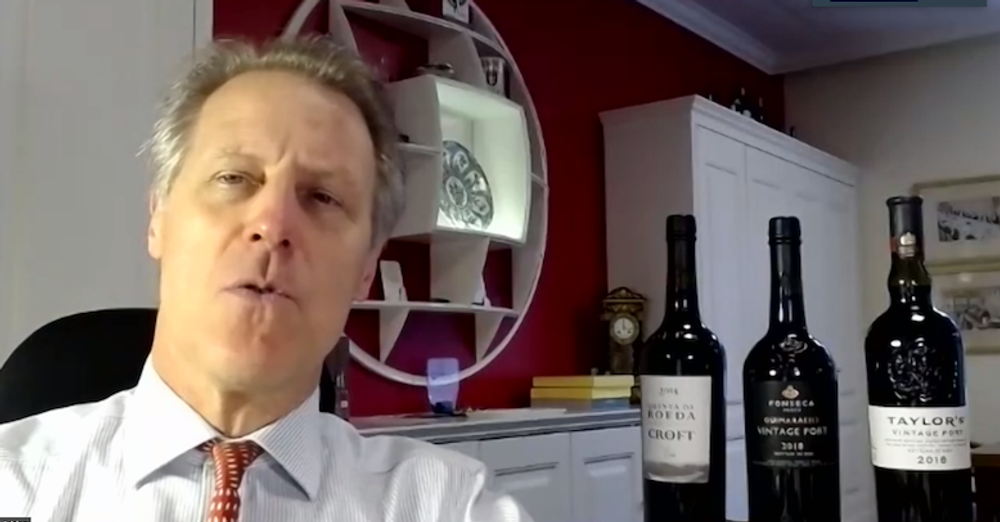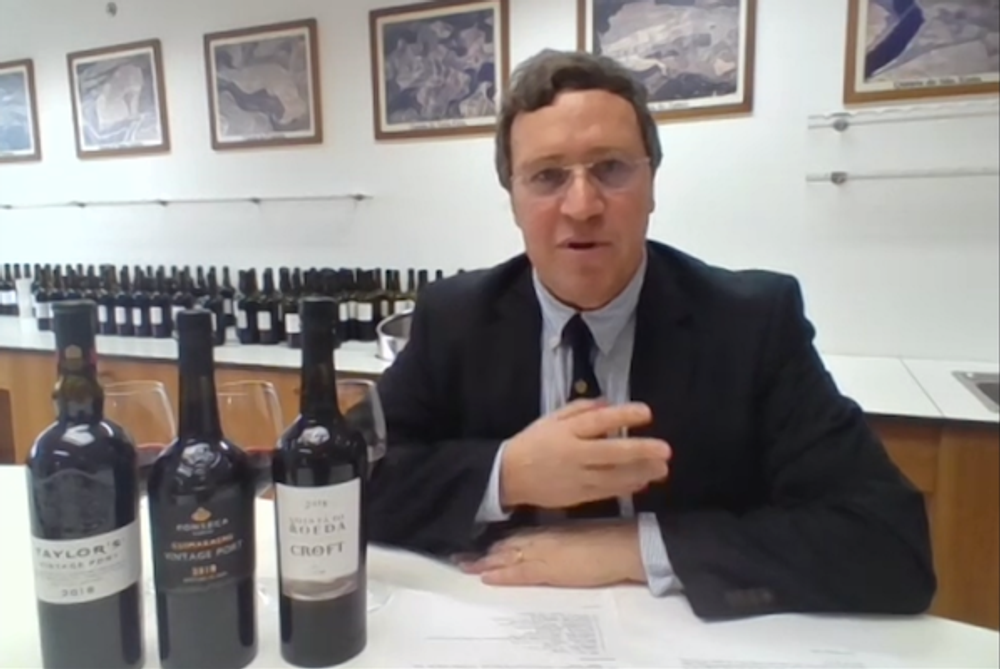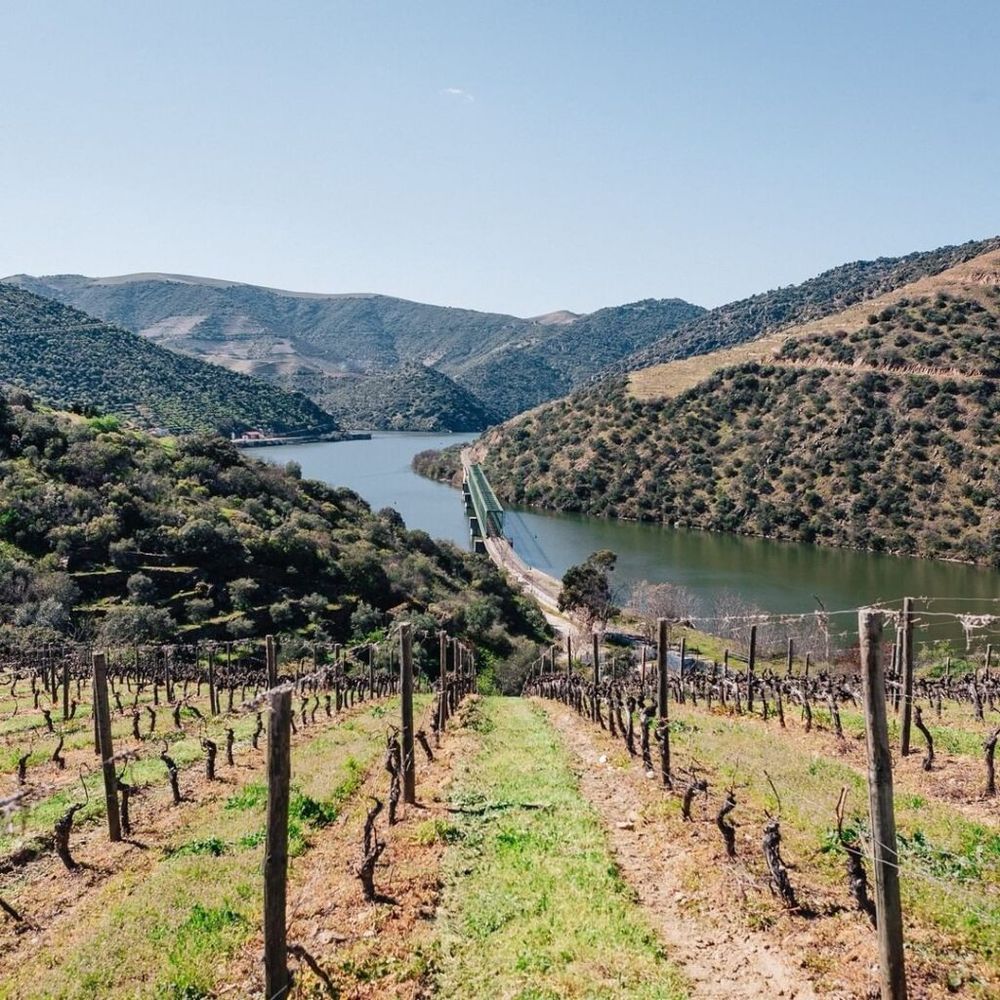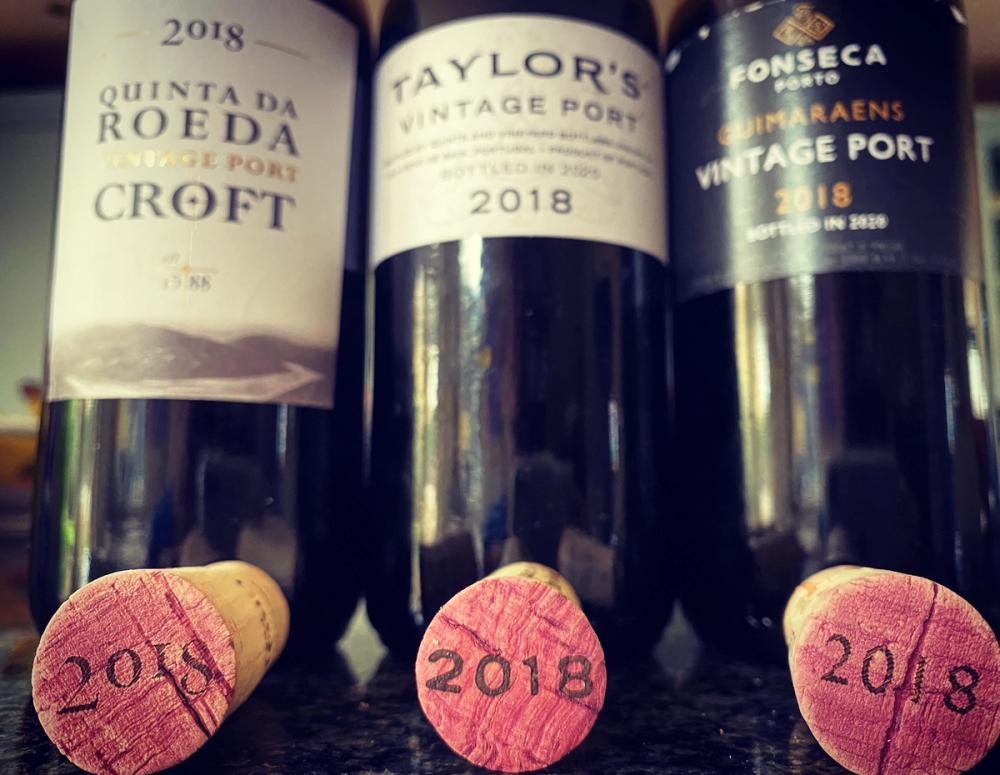“So now we are in a cycle of three very good years in a row – having the unusual back-to-back vintages and now three in a row. But the decision to declare is about the quality of port in front of you,” says Guimaraens.
When Taylor Fladgate declared Taylor’s Vintage Port 2018 last April and held back release until February this year, it was an unusual strategy – but for unusual times. There was no point releasing a new vintage, it argued, at a time when many hospitality businesses were struggling to stay afloat.
Last week at a tasting to officially launch the three Vintage Ports onto the marketplace, Taylor Fladgate managing director Adrian Bridge explained that the Americans had been pressurising them to release the wines before Christmas, but they had held off until now when, for some, there was a little light beginning to appear at the end of the tunnel.
The make-up of the new release – Taylor’s Vintage Port 2018, Fonseca Guimaraens Vintage Port 2018 and Croft Quinta da Roeda Vintage Port 2018 – could also be seen as a trio that seems a good fit for these strange times we are in. By that I mean, apart from the smart, staggered-release date, the Croft and the Fonseca could both be early drinking, both are terrific value for money, especially in my estimation the Guimaraens, and the Taylor’s 2018 is a thoroughbred Vintage Port through and through, with the price remaining at £325.00 per 6x75cl IBD – the same price as the 2017.

Taylor Fladgate managing director Adrian Bridge, February 11 2021
Bridge and head winemaker David Guimaraens both explained that, while as a business Taylor Fladgate could be more flexible in terms of release patterns and prices, it was the port in the glass which dictated whether they would make a Vintage Declaration or not. And it was unusual for 2018 to follow on from 2016 and 2017 as a declared vintage – three in a row.
“We agonised because 2018 would make three vintages in a row but you make a Declaration when the quality is right not when it is convenient or otherwise,” said Bridge. “Because of the climate though 2016 is very different to 2017 with 2018 sort of in the middle. Normally we have seen the prior year in the market but to have both wines to assess side by side and now 2018… for someone who wants to know – it is very illustrative of how port is made.”
Guimaraens explained: “2016 had a cool, damp growing season – the ports have freshness, purity and very fine tannins, but the 2017 was the total opposite, 17 was very dry, arid and very hot – and the 2017 ports have concentration from shrivel, the heat, the aromas and fruit are more concentrated, and very firm which is the character of very hot years. So 16 & 17 are opposite sides of the spectrum.”
Putting the run of three vintages in a row, Guimaraens put it into context: “In the 2000 decade we had a lot of good years, we declared in 2000, 2003, 2007, 2009 and had single 01, 04, and 08 Quinta vintages. In this decade we had 2011 which was extraordinary – tremendous for its dimension and expression – then from 2012 to 2015 we went through a number of years where we made very good ports but not at the level to declare as a classic vintage. So now we are in a cycle of three very good years in a row – having the unusual back-to-back vintages and now three in a row. But the decision to declare is about the quality of port in front of you.”
The 2018 growing season
Guimaraens then went on to explain that at various stages throughout the 2018 growing season another vintage year looked extremely unlikely.

Head winemaker David Guimaraens
“Following 2017 we were looking forward to a wet winter so the vines could get some relief but it did not happen – it was dry and very cold. By January 2018, 54% of the Douro was in extreme drought and at that point we were concerned for the health of vines, but in March the weather turned and we had 220ml of rain in March which saved the winter and gave the vines the water to start the growing season. The bud burst was very late (three weeks later than 2017) and the initial part of growing season was damp – April and May and beginning of June very damp – so it was challenging in the vineyard coping with powdery mildew.”
“In the last week of July we recorded veraison which is very late. It was quite mild going into August and then the weather changed and it was extremely hot with 44ºC on August 3 which accelerated the ripening. Although the heat did create some sunburn, because of the water in ground, we had a very good ripening. The heat carried on to 17thSept and on 22ndSept harvest started which is relatively late, but it was perfect with dry and warm days and cool evenings. So we got the freshness of the fruit – which was a character of 2016 – rich and fresh berry – and on the palate we had the structure and firmness of the 17s. So the 18s are interesting as they are a great combination of these two years.”

In September 2017 the source of the Douro dried up and, by January 2018, 54% of the region was in extreme drought
The quality of all three 2018 ports and their approachability is down to a number of factors, including the improvement in the quality of the spirits used for stopping fermentation, a change that has happened since 1991 when the Portuguese government ended its monopoly of supply (according to Bridge). For the Croft wine it is also down to the grapes being 100% foot-trodden since lagares were reintroduced in 2002.
Covid-19 meant that foot-treading did not happen in any of the Taylor quintas for the 2020 harvest, with mechanisation taking over.
Is this something that would also happen with the 2021 harvest? And did it make any difference?
Adrian Bridge explains: “We did tests on robotics and foot treading in 1995 jointly with Noval who had mechanised lagares and closed tacks using plungers and we compared these to our foot trodden and our new open top plungers. We used the same batch of grapes split into four lots and made under each individual system. We analysed the data not only from a technical perspective but also the sense of volume and completeness. We think that foot treading has an additional dimension. It may only be 1 to 1.5% better but at this level that matters. Hence we remain foot treading all our own vineyards but use that new technology just for the grapes we buy in. That has been a great contributor to our LBVs and Aged Tawny whilst reserving the ‘best’ as vintage.”
So how were the ports tasting?

Quinta da Roeda Vintage Port 2018
From Croft’s flagship estate just upstream from Pinhão this is a field blend that is aged for 18 months in large old vats.
The aromatics are characterised by a floral element (pretty violets), and there is red fruit edge (raspberry coulis) along with the fresh and dried black fruit you would expect (cherries, figs, raisins), iodine, fresh herb (eucalyptus?) and a touch of polish.
It is so approachable on the palate with integrated, silky sweet tannins, great balance, oodles of concentrated red and black fruit, red liquorice, fruit cake, cloves. The hidden tannins and slight loss of structure on the finish makes the 104 grams of residual sugar appear more evident at this stage. £85 IBD for 6 X 75cl bottles is stunning value. (2,000 cases made)
Fonseca Guimaraens Vintage Port 2018
First release since 2015 for this, Fonseca’s second label, a blend from Quinta do Panascal in the Távora Valley and Fonseca’s estates in the Pinhão Valley. 2018 is described as a cross between the fruitiness and freshness of the 2016 vintage and the structure and power of the 2017 – the quality was not there to declare a classic vintage port but that’s why Guimaraens is often such a good buy.
At such an early stage in its life, it’s a little broody on the nose, but then reveals flashes of cassis, fresh juicy blackcurrants, black cherry and plum, lovely elegance. The palate is firm and structured (much more so than the Quinta da Roeda tasted alongside) but opulent at the same time. The balance is fine with a voluptuous mix of flavours: blackberry preserve, Pontefract cake, creme de cassis, black plums, the palate is long with a a hint of black pepper on the grip. Superb. £115 IBD for 6 X 75cl bottles. (4,700 cases made).
Taylor’s Vintage Port 2018
Outstanding fruit expression characterises this blend from Taylor Fladgate’s Quinta de Vargellas in the Douro Superior (which forms about 50% of the blend) and Quintas Terra Feita and Junco in the Pinhão Valley.
Dense and almost opaque black, with a fantastically intense bouquet of rich black fruit, mint, fresh linen and a touch of white pepper; the palate is broad, rounded, rich with an undercurrent of fine, dry tannin that lets you know this is a Taylor’s vintage port and this is for keeping – not drinking now. Elegant, hedonistic blend of fresh, intense black fruit with real power and grip on the palate. £325.00 per 6x75cl IBD. (7,800 cases made)
Taylor Fladgate ports are imported into the UK by Mentzendorff, which is a supplier partner of The Buyer. To find out more about them click here.








































